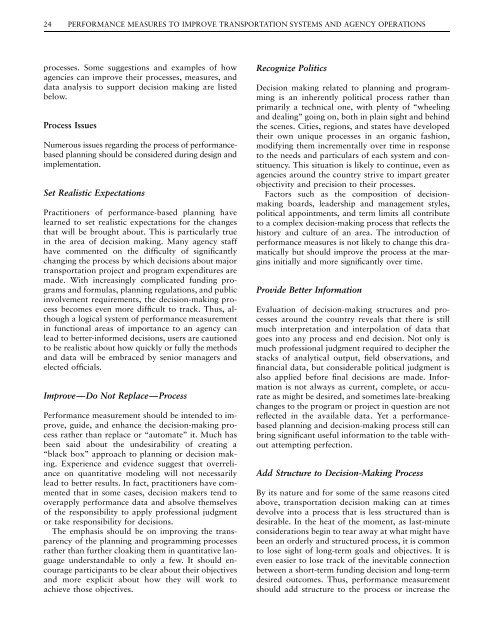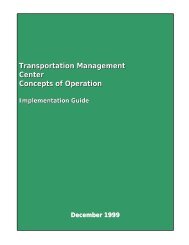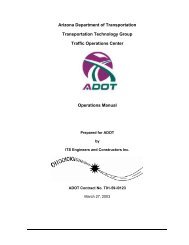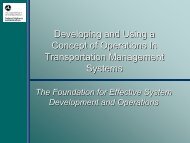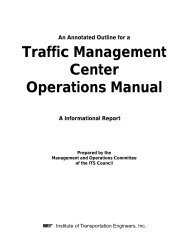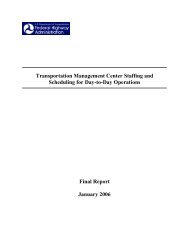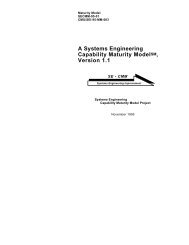Conference Proceedings 26 - Transportation Research Board
Conference Proceedings 26 - Transportation Research Board
Conference Proceedings 26 - Transportation Research Board
- No tags were found...
You also want an ePaper? Increase the reach of your titles
YUMPU automatically turns print PDFs into web optimized ePapers that Google loves.
24 PERFORMANCE MEASURES TO IMPROVE TRANSPORTATION SYSTEMS AND AGENCY OPERATIONSprocesses. Some suggestions and examples of howagencies can improve their processes, measures, anddata analysis to support decision making are listedbelow.Process IssuesNumerous issues regarding the process of performancebasedplanning should be considered during design andimplementation.Set Realistic ExpectationsPractitioners of performance-based planning havelearned to set realistic expectations for the changesthat will be brought about. This is particularly truein the area of decision making. Many agency staffhave commented on the difficulty of significantlychanging the process by which decisions about majortransportation project and program expenditures aremade. With increasingly complicated funding programsand formulas, planning regulations, and publicinvolvement requirements, the decision-making processbecomes even more difficult to track. Thus, althougha logical system of performance measurementin functional areas of importance to an agency canlead to better-informed decisions, users are cautionedto be realistic about how quickly or fully the methodsand data will be embraced by senior managers andelected officials.Improve—Do Not Replace—ProcessPerformance measurement should be intended to improve,guide, and enhance the decision-making processrather than replace or ‘‘automate’’ it. Much hasbeen said about the undesirability of creating a‘‘black box’’ approach to planning or decision making.Experience and evidence suggest that overrelianceon quantitative modeling will not necessarilylead to better results. In fact, practitioners have commentedthat in some cases, decision makers tend tooverapply performance data and absolve themselvesof the responsibility to apply professional judgmentor take responsibility for decisions.The emphasis should be on improving the transparencyof the planning and programming processesrather than further cloaking them in quantitative languageunderstandable to only a few. It should encourageparticipants to be clear about their objectivesand more explicit about how they will work toachieve those objectives.Recognize PoliticsDecision making related to planning and programmingis an inherently political process rather thanprimarily a technical one, with plenty of ‘‘wheelingand dealing’’ going on, both in plain sight and behindthe scenes. Cities, regions, and states have developedtheir own unique processes in an organic fashion,modifying them incrementally over time in responseto the needs and particulars of each system and constituency.This situation is likely to continue, even asagencies around the country strive to impart greaterobjectivity and precision to their processes.Factors such as the composition of decisionmakingboards, leadership and management styles,political appointments, and term limits all contributeto a complex decision-making process that reflects thehistory and culture of an area. The introduction ofperformance measures is not likely to change this dramaticallybut should improve the process at the marginsinitially and more significantly over time.Provide Better InformationEvaluation of decision-making structures and processesaround the country reveals that there is stillmuch interpretation and interpolation of data thatgoes into any process and end decision. Not only ismuch professional judgment required to decipher thestacks of analytical output, field observations, andfinancial data, but considerable political judgment isalso applied before final decisions are made. Informationis not always as current, complete, or accurateas might be desired, and sometimes late-breakingchanges to the program or project in question are notreflected in the available data. Yet a performancebasedplanning and decision-making process still canbring significant useful information to the table withoutattempting perfection.Add Structure to Decision-Making ProcessBy its nature and for some of the same reasons citedabove, transportation decision making can at timesdevolve into a process that is less structured than isdesirable. In the heat of the moment, as last-minuteconsiderations begin to tear away at what might havebeen an orderly and structured process, it is commonto lose sight of long-term goals and objectives. It iseven easier to lose track of the inevitable connectionbetween a short-term funding decision and long-termdesired outcomes. Thus, performance measurementshould add structure to the process or increase the


